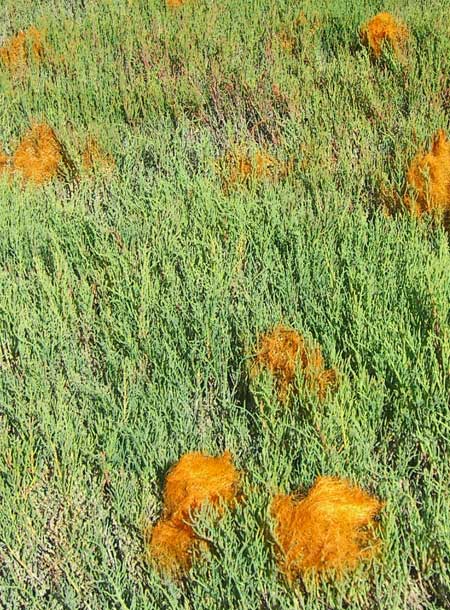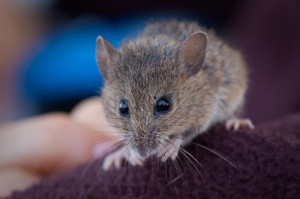This article is part of our EndangerBus project — watch for the buses in San Francisco January 2011!
- The bright green plants here are pickleweed, forming a dense stand of food and cover that’s a favorite of the endangered salt marsh harvest mouse. The orange plants are marsh dodder, also a pickleweed predator after a fashion — it parasitizes off the pickleweed. Creative commons photo by Mary Mactavish.
Every once in a while, a small and unremarkable animal makes a huge impact on a landscape. So it is with the salt marsh harvest mouse around the edges of the San Francisco Bay. The endangered species status of the diminutive harvest mouse, along with that of the similarly endangered California clapper rail, has been a prime mover in the restoration of tens of thousands of acres of tidal marshes around the region.
Unfortunately, that’s because these animals’ populations are in such dire straits. Requirements to protect the remaining individuals in the South and North Bay have given legal leverage to efforts to protect and restore marshes.
These tiny rodents, just a couple of inches long and about the weight of a nickel, depend on healthy, intact tidal marshes that do two things: grow a lot of pickleweed (their favorite food) and ascend gradually into areas with dense vegetation, so the mice can safely escape to high ground during the highest of high tides.
Coastal filling and levee-building have been hard on these kinds of landscapes. During the last two hundred years, farming and development filled tidal zones, and often surrounded what was left with steep-sided, barren levees at the water’s edge.
Without pickleweed, glasswort, and other salt marsh plants, the mice starve. And without cover, they’re easy prey for hawks and other birds, nonnative red foxes, and neighborhood cats. Though the mice are good swimmers and can subsist on saltwater for long periods, they can’t travel far to better habitat if their home marshes are disrupted. When you weigh less than an eighth of an ounce and can’t fly, long distance travel is pretty much out of the question.
It’s hard to say what role the these mice serve in the larger ecosystem, though that’s no reason not to protect them. Howard Shellhammer, one of the foremost experts on these tiny mammals, tells us, “No one really knows much about their role or roles. They are food for clapper rails within the marshes and a variety of birds. Other than that there really is not a lot of data or information.” That’s mostly due to sparse funding for sustained study. And it’s also just the nature of science. “Like most things scientific,” says Shellhammer, “the more one knows the more questions he or she has. I know a lot about (salt marsh harvest mice), and I have more questions than anyone.”
Fortunately for the mice, a host of agencies and nonprofits, from the U.S. Fish and Wildlife Service to Save the Bay, are working all over the region to protect and restore marshes. Indeed, taken together, the efforts around Alviso south of Fremont and along Highway 37 near Vallejo make up the second-largest ecosystem restoration project in the country.
With luck, those and other efforts will protect and reestablish salt marsh harvest mouse populations faster than predators, development, and sea level rise work to eliminate them.
For more about the salt marsh harvest mouse:
A Marsh is a Marsh is a Marsh . . . But not Always to a Salt Marsh Harvest Mouse, by Howard Shellhammer

.jpg)




